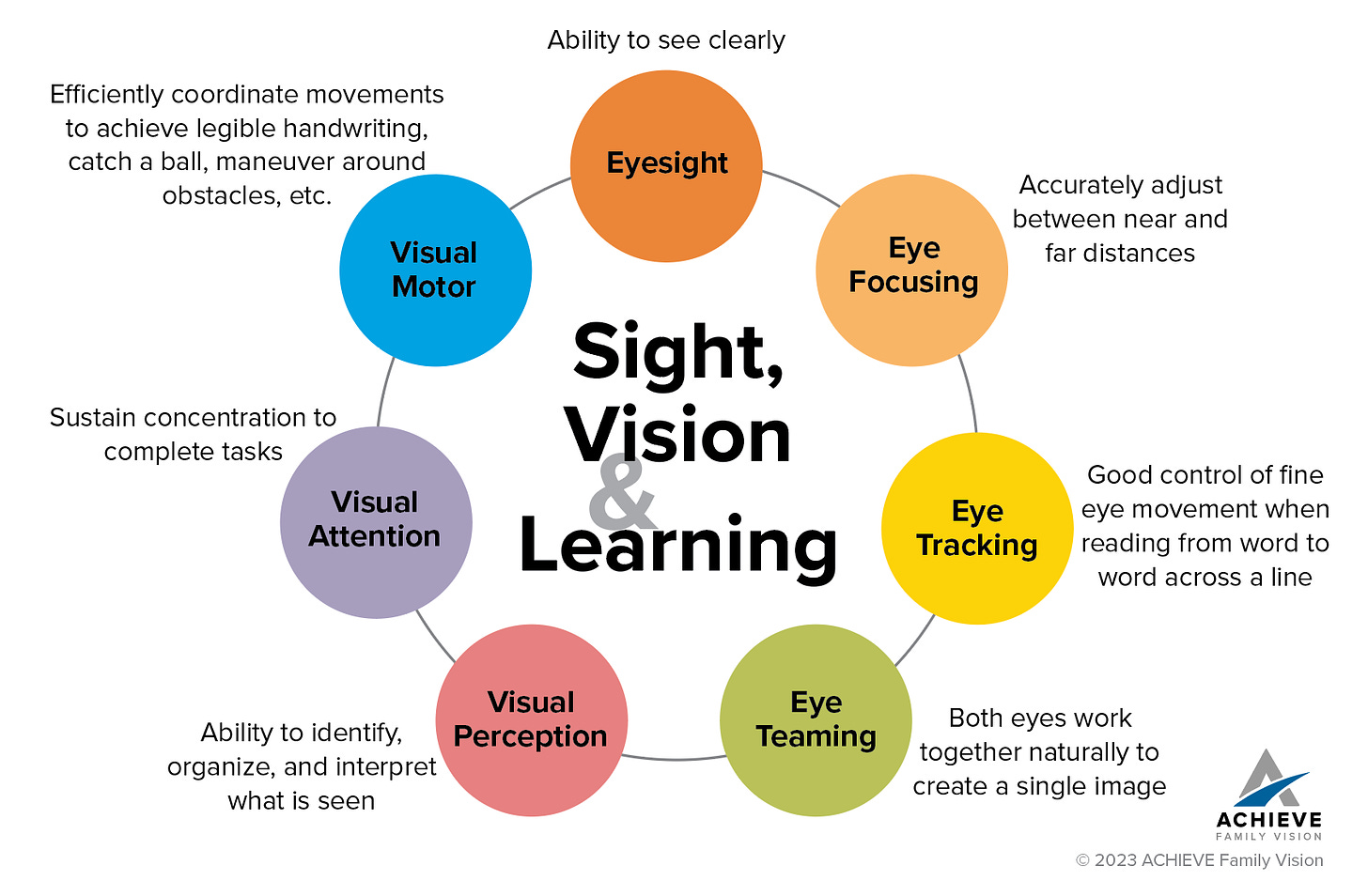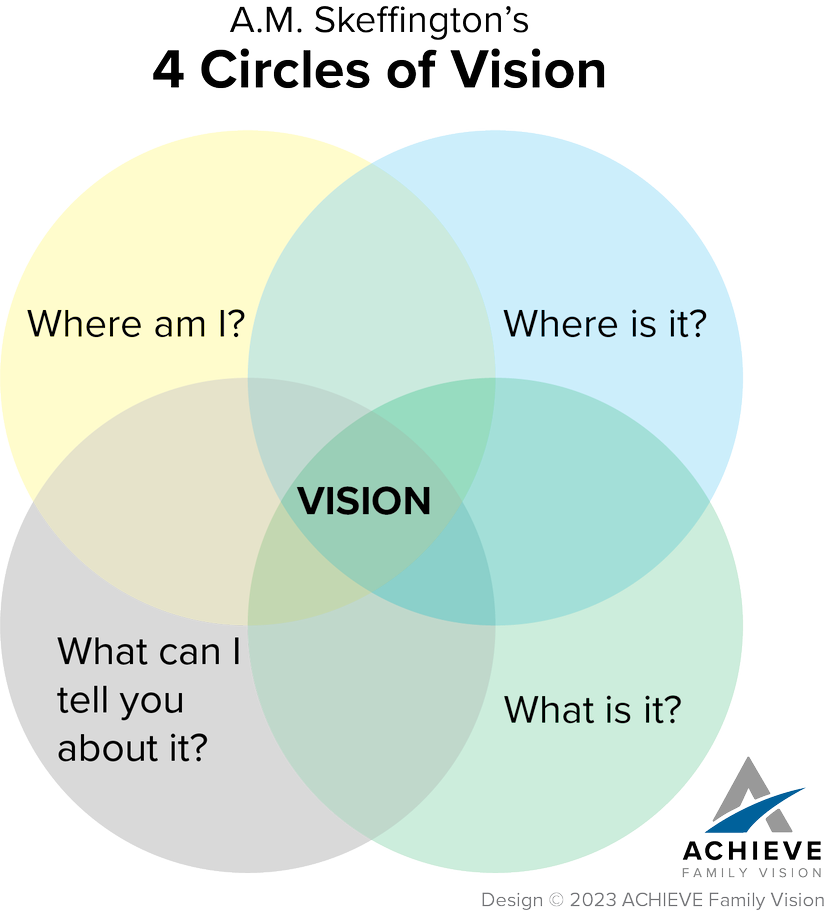Sight vs. Vision: An Eye-Opening View on Overall Health and Success
When our children struggle academically or socially, we worry. We employ the help of specialists. We hire tutors. We confer with their teachers and others who share our interest in their success.
Most parents, teachers, and others who love children and feel concerned for their success are unaware of the direct link between vision-related deficits and social and academic performance. We hope to help you grasp this correlation and see a path to workable solutions. It all begins with a greater understanding of sight, vision, and how they interact.
Sight vs. Vision
Let’s jump right in by defining the distinction between sight and vision.
Sight refers to how clearly we see things optically. For example, “20/20” refers to being able to identify a specified size letter from 20 feet away.
Vision is much more complex, with sight being the gateway to multiple integrated systems the brain uses to allow us to interact with others and our environments. These systems also help us reduce stress and promote our own overall health.
Vision includes the following seven integrated components:
Eyesight (visual acuity)
Eye Focusing (accommodation)
Eye Tracking (ocular motor function)
Eye Teaming (binocularity)
Visual Perception (vision information processing)
Visual Attention (sustained visual concentration)
Visual Motor (motor coordination of bodily movement)
When these seven elements are working in harmony, we are able to fully function. A powerful way to understand how these functions work together in our everyday lives is represented in the following Venn diagram illustrating A.M. Skeffington’s explanation of vision.
The emergent, or overlap, of the four processes represented in the diagram is where optimal vision takes place. Let’s look at these four processes briefly:
Process #1: “Where am I?”
This system involves the integration of our internal senses – our sense of balance, our internal awareness of where the parts of our body are and where they are in relation to each other, and the reflexes that are preprogrammed before birth that kickstart development and direct how we react to changes in our environments.
Process #2: “Where is it?”
This process is an integration of our external senses – sight, hearing, and touch – which promote accurate depth perception. It helps us understand spatial relationships.
Process #3: “What is it?”
This process requires higher level processing. This is where we discover detail and definition. It allows us to understand sameness and differences. It allows us to discriminate. It integrates with our memories. An example of processing at this level is that a child knows the difference between a dog and a horse, even though each has four legs, a tail, two eyes, ears, and a nose. Despite the sameness of these two animals, the child is able to identify these specific animals because of their differences.
Process #4: “What can I tell you about it?”
This process integrates verbal and non-verbal communication. It helps us relate our experiences with others’ experiences. It allows us to align our realities with external realities, including those of other people. This portion of the complete scope of vision is key to social development and interaction.
“Why Haven’t I Ever Heard This Before?”
This is a common question since this is likely all new to you. Don’t feel like you missed out somehow or that you should have known these things. Most people don’t. As you can now see (pun intended), however, with this brief introduction, there are many issues we don’t commonly associate with vision that are – at their root cause – in fact, vision-related problems. When these underlying matters go unaddressed, we fail to help our children reach their full potential in interacting with others and their environments, as well as helping them protect themselves, feel safe and confident, and excel academically.
An assessment of your child’s functionality with these four processes identifies any troubles they are experiencing in one, two, three, or all four of these areas. Only addressed holistically can any shortcomings in these processes be identified and successfully addressed.
Let’s Discover Real Answers Together
When children struggle with learning, have difficulty reading, or are disruptive, it’s often because they are experiencing – with no fault on their part – a shortfall in one of the areas we have discussed. This type of disorientation or confusion is often the reality behind their learning challenges (which have long been referred to as “learning disabilities,” a term with which we do not agree). We know children are able. They just need assistance in training these processes to interact with each other functionally.
The good news is that there are real answers to these potentially baffling realities. If you’d like to discover more, we’re here to help. Just call us to set a brief appointment time to visit with one of our neuro-developmental optometric doctors. In short order, you’ll have meaningful answers to your questions and be on your way to providing your family with the highest, most advanced level of care available.
Thank you for being our patient and a member of the ACHIEVE family. And thank you for the trust you show in us when you send your friends and family to us so they, too, can experience vision care that goes well beyond eye exams.
Dr. Mark Curtis, OD, FCOVD
Dr. Jeremy Gardner, OD, FAAO
Dr. Christopher Pope, OD






